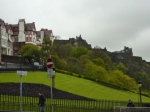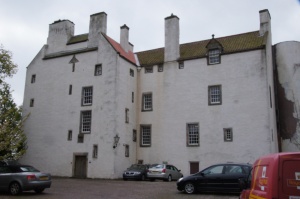I’m back home, after an excruciatingly long flight from Scotland that involved at least eight hours of flight delays. I was sorry we picked the day I returned to bring home our new puppy, because I was a weary mess.
The purpose of my trip was to see as many of the historical sites important to Mary, Queen of Scots and her Four Maries and kick off a fierce summer of writing with the goal of completing the first draft of my novel by the end of the year. So how did I do? What did I really accomplish? And, was it even necessary in the era of Google Earth/Google Images? Was I just on a big fat boondoggle? (What’s a boondoggle? It is when you go somewhere under the guise of doing work or business and in fact it is more party than anything else. Favorite American expression.)
Yes! I admit there was an element of boondoggle about my journey. My parents are from Scotland (Fife) and I spent a lot of time there growing up. Returning to see my cousins and old friends was fantastic, and I could have spent the two weeks roaming around seeing them. As it was, I did not get to visit every relative and friend I had hoped to see. Next time…
Could Google Earth have been a solid substitute? I have a friend who writes romance novels and has written one set it Germany and England without ever having set foot in either country. I thought she did a good job capturing England in the 1980s—and I was there at the time. I’m writing about the 16th Century, which I can’t visit either. So did being on the ground, viewing ruined castles help me write more detailed scenes?
I did a fair bit of research on Google Earth and Google Images and while it was helpful, there was nothing like being on site, or en route to a site. I’d seen plenty of photographs of Hermitage Castle but nothing I saw prepared me for the sheer size of it tucked away in the lonely Borders. No photograph can capture the pure joy I felt traveling through the Scottish countryside on a sunny day, or the miserable feeling I got when on a rainy day the relentless damp chilled my bones. My characters will feel that too.
As I went from place to place, photographing the ruins and researching what happened at each site, I was a little surprised at how being on the ground in castles like Loch Leven, Hermitage, Stirling gave me a greater appreciation for the chaos and strife of Queen Mary’s short, 7-year residence in Scotland during her reign. I have known Queen Mary’s story since I was 12 and read Lady Antonia Fraser‘s biography Mary Queen of Scots (yes, I was a precocious child). But knowing a story and feeling it are quite different.
Being on the ground here, I saw my characters a little differently, more deeply. From the minute I hit the runway at Edinburgh airport I was more aware of the what it was like for five young women under 20 to return to their native lands and their families as almost foreigners. They were, for all intents and purposes, French women but now expected to pick up a culture and life they had left behind 13 years earlier. I could even liken their experiences to my own.
As I traveled to the sites and focused on what happened in the lives of Queen Mary or the Maries at each, it hit home how crisis-driven their lives became once they returned to Scotland. I think of Queen Mary and her Maries as the “it” girls–the celebrities–of their day at the cutting edge of Renaissance culture and fashion. They caused comment wherever they went, whatever they did–and tabloid talk followed. John Knox was like our on TMZ or News of the World. Queen Mary was a lightning rod for scandal—men fell deeply in love with her (John Gordon, Chastelard, Willie Douglas), never mind the men who wanted her crown (Darnley, Bothwell just for starters).
In that environment, I start to wonder what kept Queen Mary going? Even after her low point, imprisoned at Loch Leven, she pulled herself together and escaped, rallied troops and went into battle. She was no coward, no shrinking violet and neither were her Maries. Seton was bold enough to join her at the Battle of Carberry, then body-double for Mary in her escape from Loch Leven, run with her to England, sharing her imprisonment. Livingston likewise was at Carberry and she held onto Mary’s jewels and money even under duress from the Regent Morton as late at 1573. Fleming and her husband held Edinburgh Castle in what can only have been diabolical conditions.
Queen Mary lurched from one crisis to the next, doing her best to manage each. But with each crisis the stakes were raised higher and she finally lost everything. Once Queen of France and Scotland, she spent half her life imprisoned. And yet Queen Mary’s cause was not lost the day she fled to England–there were many, many in Scotland who remained loyal to her. Not just Edinburgh Castle, but also Doune Castle and Dunbar held for her up until early 1570s, after she was under Elizabeth I’s eye. Her Maries, their husbands and families all worked for her release and did not give up on it for a long time. Queen Mary had been escaping from one sort of danger or another since her mother removed her from Linlithgow to Stirling in case she was abducted and taken to England at seven months old. There was no reason to think once in England she would never see Scotland again.
For me, I can’t imagine writing this book without spending time in Scotland in the footsteps of my characters, seeing the worn stone steps in an ancient castle and knowing my characters helped with the wear and tear, or the fireplace where they would have sat and warmed themselves on a cold day, or following the route they took from one location to the next.
I admit I did not achieve everything I hoped to. I could easily have spent another two weeks, or three, to really cover the ground. And I might yet before it’s all done. Remember, Queen Mary spent a lot of time in France…and England…Just sayin’.
In the meantime, I have journals and drafts and ideas floating in my head and a summer to get them all cohesively on paper. Carpe Diem!
Related articles
- Historic St. Andrews; Queen Mary’s Great Escape from Loch Leven (thehistorylady.wordpress.com)
- Last day castle-hopping – Callendar House, Linlithgow Palace and Lennoxlove (thehistorylady.wordpress.com)
- Tabloid Scandal of 1566 – Queen Mary’s Jaunt to Hermitage from Jedburgh (thehistorylady.wordpress.com)
- On Mary Stuart’s Return to Scotland (and mine) (thehistorylady.wordpress.com)
- Rossend, Scene of Mary, Queen of Scots Scandal with Chastelard and Falkland Palace, Her Favorite Hunting Lodge (thehistorylady.wordpress.com)











































